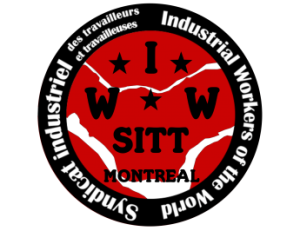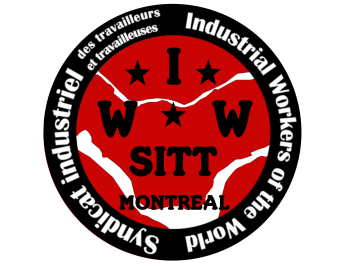The origins of Solidarity Unionism: minority report 2
At the most recent General Assembly of the IWW, I had the chance to participate in a panel discussion to share ideas on how to rebuild the labor movement. My exchange theme was minority unionism. Here are some excerpts:
If the unions must become a movement, we must come out of the current model, based on a recipe increasingly difficult to prepare: a majority of workers vote union, a contract is negotiated. We must return to the kind of unrest that has earned us the eight-hour day and built the unions as a vital force. One way of doing this is what is now called the “minority unionism”. It's a question of constituting organized solidarity networks and significant improvements can win on individual workplaces, in industries and for the benefit of the international working class.
The minority unionism occurs on our own terms, irrespective of the legal recognition. It is not a question of simply creating a small clique of professional malcontents. It should rather aspire to grow, but in the short term, He gives an example of possible types of organization when we decide that our unions will exist because we need.
Diets working relationship between the United States and Canada are established on the assumption that the majority of workers must have a union, generally approved by the government in a global context, which is relatively rare. Even in North America, the idea that a union needs official recognition or majority status for the right to represent its members is relatively recent, mainly thanks to the choice of the unions to the legal trade of membership guarantees.
The labor movement was not built by the majority unionism – it could not exist. A hundred years ago, the unions had no legal status (indeed, courts have often ruled that unions were an illegal conspiracy and constituted a form of extortion) – they were recognized by their gross industrial power.
When the IWW fought for the eight-hour day in the wood and wheat fields, they have not decided to prove their majority in boss through elections. Workers have rather held meetings to decide what their claims, elected shop committees to represent claims, and used tactics such as leaving work after a quarter of eight hours to persuade recalcitrant employers to accept their demands. Union recognition in the construction trades was carried out through a combination of strikes, direct action and respect stakes grêve and of each other (and which, often, not enough).
The wave of sit-ins that have implemented the IOC in auto and steel, for example, was undertaken by minority unions who were very present in the workplace with agitating history. The union then appealed to the minority presence to take direct action that galvanized the largest workforce in their factories and have inspired the continent workers.
Trade unionism was built through direct action and through the organization of work. But in the years 1930, bosses have been increasingly difficult to recruit thugs and friends judges, and to proceed with collective redundancies. Recognizing that there was no way to crush the unions and tired of the continuous conflicts, they proposed an agreement: if the unions agreed to abandon their industrial power and instead worked through appropriate channels – the National Labor Relations Board in the United States, various provincial offices in Canada – the government would act as a referee “impartial” to determine whether the union was or not bona fide workers' representative.
Short term, unions could bypass the need to sign the workers one by one, to collect premiums directly. Bosses exchanged suit unionists for the thugs they had previously employed. And after a brief period of membership, trade unions (particularly in the US) began a long spiral. As part of this exclusive negotiation model, unions do not attempt to work on the job as long as they have not obtained legal certification. This legal process provides employers an almost unlimited ability to threaten and intimidate workers and drag out proceedings for years. It is a system designed to interfere with the right of workers to organize – and the IWW emphasized when the national law on labor relations was adopted.
However, if the labor law system is designed around this majority-majority unionism, he does not really require. As long as workers act together, they enjoy the same basic legal rights – such as those – whether or not in an officially certified union. Indeed, in some cases, they enjoy more rights, the courts have ruled that most union contracts implicitly refer to the right to strike. It is illegal to fire members of a minority union for trade union activity, to discriminate, to dismiss for strike, to refuse to allow union representatives to attend disciplinary hearings, etc. An organized group of workers have legal rights, but it would be wrong to expect that labor boards more vigorously apply than they do for unions that have been certified. And an organized group of workers, even if it is a small minority, has much more power than the unorganized individual workers.
In most of the cases, you have as many legal rights as a majority union as a minority union – with the only exception being certified as the exclusive bargaining agent and sole authority to negotiate a contract. A minority union has the right to file grievances (even though there may be no formal complaints procedure); engage in a concerted activity, make requests to the boss; seek meetings, or even trigger a grêve (even if it's not a good idea if you do not have the support of the majority).
If you choose well your problems and use them as an opportunity to talk with colleagues and mobilize, you can fight together for better conditions and build a 'union'. By campaigning on issues that matter to your colleagues, you acquérerez experience in self-organization, you will learn that you can trust, and you establish that the union of workers on the job and they are there for a long time.
The labor movement was built when workers groups have banded together and began agitating for their demands: sometimes, they persuaded their colleagues to approach their boss and ask that some problems are corrected. Sometimes, they refused to work under working conditions or unsafe manner, and persuaded their colleagues to do the same. Other times, they acted individually, sometimes they were demonstrations across the city on issues of common interest such as working hours and hazardous work.
The crucial point is that they acted. They identified the key elements of their problems; they got together, they agreed to an action plan, then they executed. It is the trade union action. It does not require official recognition, it requires no contract. It requires Workers who join together and act collectively.
If the unions must become a movement, we must come out of the current model and return to the type of agitation on the ground that we won the eight-hour day and built the unions as vital force. The minority unionism is to form organized networks of solidarity and significant improvements can win on individual workplaces, in all industries and the benefit of the international working class. This is a process, a process that offers hope to transform our greatest weakness – the fact that our members are scattered in many workplaces largely disorganized – into a force.
The series of “minority reports” was written and published in 2002 on the website of the IWW, by Alexis FW Buss.
Link to original article: https://www.iww.org/about/solidarityunionism/explained/minority2



 In the last twenty years we have seen the generalization of precarious working conditions, flexible schedules and broken jobs, on call and on terms less interesting. This transformation of work and jobs corresponds to the employers' desire to bring workers to their knees and restore their profits by strengthening wage exploitation. The current economic crisis will further worsen the precariousness of employment and the flexibility of the workforce..
In the last twenty years we have seen the generalization of precarious working conditions, flexible schedules and broken jobs, on call and on terms less interesting. This transformation of work and jobs corresponds to the employers' desire to bring workers to their knees and restore their profits by strengthening wage exploitation. The current economic crisis will further worsen the precariousness of employment and the flexibility of the workforce..